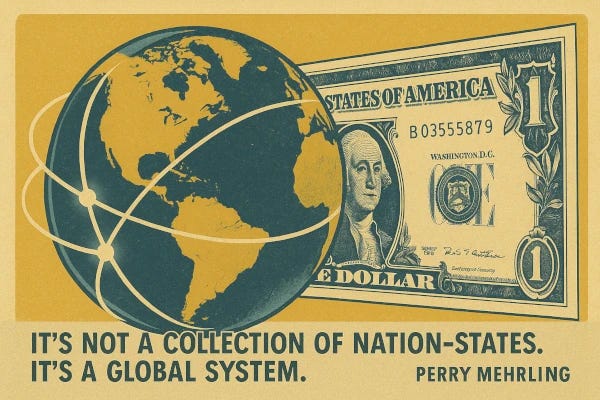1:1 Money Is Global
The Myth of Monetary Sovereignty
This blog has been preparing us for Perry Mehrling's Economics of Money and Banking course (2012). Now it's time to dive in.
Clip Length 4:51 (Lec 1:1, 0:06–4:57)
The big thing that we're trying to figure out—everyone's trying to figure out—is financial globalization. … What I've learned from reading the history of monetary thought—the history of financial thought—is that every generation has to figure out the world in front of them. The world is changing. This is a system that is not constant.
(Lec 1:1, 1:55)
Money is global. Payments do not stop at the border. Neither does funding. International payments are just payments that happen to cross arbitrarily drawn political boundaries. Capital flows are just financial transactions that happen to cross those boundaries.
Our task is to work out the implications of financial globalization for how we understand money, banking, and central banking.
(Lec 1 Notes, 1)
Mehrling starts with an emphasis on globality, but he doesn't really explore the global perspective until the second half of the course. For now, we can imagine that the whole world is like one country running on the US dollar as its currency. In terms of money, banking, and finance, that's not too far from reality. As we flesh out the details of this global system, we can start to differentiate between nations, currencies, and central banks.
We tend to like to think that we live in countries—that our monetary system is the monetary system of our country. … and that, somehow, it all gets added up into an aggregate. This is just not the way the world is. It's not a collection of nation-states; it's a global system, and each central bank is part of this hierarchy.
(2017 Lec 1, 44:45)
Individual countries want to believe that they can control their own monetary systems, but they don't have their own monetary systems. There is one system: a global system. It doesn't "belong" to a single nation.
No sovereign wants to be told that monetary sovereignty is a myth.
(Mehrling 2022, 166)
Mehrling's most recent book, Money and Empire: Charles P. Kindleberger and the Dollar System (Mehrling 2022), tells the story of how the US dollar found its way to the center of the global monetary system.
Our system is now a global dollar system. We might not want that to be true. But if we try to manage our monetary system as if it's the system we want rather than the system we have, we'll break the system we have.
What is liable to happen, if there is a failure of international credit, is that nations will turn in upon themselves, becoming more autarkic or more protectionist, impoverishing themselves and each other by refusing to trade with each other. (And this means, we can already see, refusing to aid each other.) That is the danger with which we are confronted; we can already see that it is no imaginary danger at this present time.
(Hicks 1967, 172)
References
Hicks, John. 1967. "Monetary Theory and History." In Critical Essays in Monetary Theory, 155–173. Oxford: Clarendon Press.
Mehrling, Perry. 2012. Economics of Money and Banking. Online course. Coursera. Accessed 2015–2025. https://www.coursera.org/learn/money-banking.
Mehrling, Perry. 2012a. "Lecture 1: The Four Prices of Money — Part 1: The Big Picture." Economics of Money and Banking, Columbia University, recorded September 5, 2012. Video of lecture, 19:25. https://youtu.be/KNEouYM5wRE
Mehrling, Perry. 2013 Lecture 1 Notes: The Four Prices of Money. https://sites.bu.edu/perry/files/2019/01/Lec-01-The-Four-Prices-of-Money.pdf
Mehrling, Perry. 2017. "Lecture 1: Why Is Money Difficult?" Warsaw School of Economics, recorded October 11, 2017. Video of lecture, 1:33:46. https://youtu.be/9DozcacGdYI.
Mehrling, Perry. 2022. Money and Empire: Charles P. Kindleberger and the Dollar System. Cambridge: Cambridge University Press.


